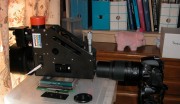Weather
Three clear nights in a row? Not until it’s over do I believe it – besides, both of the previous nights included cloudy periods. Hot today – mid to upper 90s, tonight 86-80F, humidity 65-70%, calm winds. Seeing looks t be a bit better than 2 arscec.
As per each “clear” night recently – some clouds did move through, this time just as I was beginning the third time through the sequence of WR stars. So I quickly moved to Beta Apr and got a couple of spectra there (one poorly focused). Waited out the clouds (45 min?) then resumed.
Rig #1: Spectra of WR134, 135 and 137.
Three sets – 30 min each, plus a visit to Beta Aqr.
Rig #2: J191502+071947
100 second integrations. With the moon moving towards full not sure how many more nights of this object, which is beginning to flirt with 17th mag.
Focus, asymmetrical profiles
So tonight I kept every spectrum at column 180 on the guide camera. I tried to focus before each spectrum, by maximizing the peak pixel value. Still, the traces were badly asymmetrical. In fact, for the Beta Aquarii spectrum I tried focusing on the “ghost” image that appears just below bright stars (internal reflection in the glass slit). Fail! Not surprising – but the resulting cut through the spectrum clearly showed the image was out of focus – double peak which would indicate being far enough out of focus that the shadow of the secondary mirror is visible. After that I changed tactics and tried focusing to achieve the smallest FWHM. That seems to work pretty well, but still the profiles are asymmetrical.
One fairly interesting thing I’ve noticed is that as things cool off I have to “raise” the mirror – to push focus back farther. Now with just a camera the opposite is true. Makes sense since falling temperatures causes the aluminum tube to shrink – so to keep the focus at the same place I need to move the mirror back so that the focal plane moves toward the front of the telescope, compensating for the shrinking tube. So why is the spectrograph different? Perhaps it’s thermal expansion and contraction is larger than the telescope’s? Not sure what the body of the instrument is made of but I’m guessing steel. Wonder what it’s coefficient of thermal expansion is compared to Al.
Out at 3:45am – left darks running on Rig #1.














